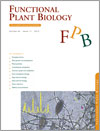
Functional Plant Biology
Volume 40 Number 11 2013
FP13023Profiling of secondary metabolites in blue lupin inoculated with Phytophthora cinnamomi following phosphite treatment
Native flora in Australia can be devastated by the soil borne pathogen Phytophthora cinnamomi. The infected plants can be chemically treated to inhibit the pathogens; however, we have little understanding of the underlying mechanism involved in this process. This paper shows that the chemical phosphite acts directly on the pathogen rather than indirectly through a secondary process.
FP13007A dynamic model of tomato fruit growth integrating cell division, cell growth and endoreduplication
The model of tomato fruit growth developed in this study integrated three main cellular processes (cell division, cell growth and endoreduplication) and was able to predict fruit growth under contrasting assimilate supply and temperature conditions. With this model, we improve the understanding of assimilate supply and temperature effects on fruit and cell phenotype as well as the physiological mechanisms that explain genotypic and environmentally-induced variation in fruit growth.
FP12330Proteomic analysis during capsicum ripening reveals differential expression of ACC oxidase isoform 4 and other candidates
Capsicum fruit is considered non-responsive to ethylene (or non-climacteric) and will not ripen properly if harvested green. We compared different capsicum ripening stages using a proteomics approach and identified an enzyme important for ethylene production that was upregulated during ripening. RNA expression and enzyme activity increases were confirmed, suggesting that even though capsicum is non-climacteric, fruit may have a conserved mechanism for ripening involving ethylene.
FP12265Cloning, functional characterisation and transgenic manipulation of vitamin E biosynthesis genes of wheat
Tocochromanols are antioxidants which provide protection from oxidative stress. Two important enzymes of their biosynthesis pathway in wheat, TaHPPD and TaγTMT, were overexpressed in transgenic Arabidopsis, resulting in alterations in tocochromanols and performed better under osmotic stress. Transgenic wheat plants overexpressing TaHPPD showed 2.4-fold higher tocochromanol content. Further analysis of these lines provides insight about their antioxidative roles.
FP13105Starch reduction in rice stems due to a lack of OsAGPL1 or OsAPL3 decreases grain yield under low irradiance during ripening and modifies plant architecture
Starch accumulation in the stems of rice is reported to be important for improving and stabilising grain yield, especially in suboptimal environments. Our analysis of a low stem starch mutant revealed starch accumulation is indispensable for normal ripening under low irradiance conditions and probably contributes to the maintenance of appropriate plant architecture. These findings may offer new insights into rice breeding to improve plant architecture.
FP12345Consequences of elevated temperatures on legume biomass and nitrogen cycling in a field warming and biodiversity experiment in a North American prairie
Warming-induced changes to the nitrogen cycle can have significant impacts on plant communities. We examined the response of four prairie legumes to elevated temperatures. Warming increased biomass but decreased the percentage of nitrogen in the stems and leaves of these plants. These results suggest small but significant legume-mediated changes to the nitrogen cycle of prairies may lead to changes in plant communities.
FP12369Acclimation of leaf dark respiration to nocturnal and diurnal warming in a semiarid temperate steppe
Climate change could dramatically affect ecosystem functions through its impacts on physiological processes. The aim of this study was to examine different responses of leaf dark respiration to asymmetric diel warming, daytime versus night-time. Our results show that night-time leaf respiration significantly acclimated to warming, but daytime respiration demonstrated little thermal acclimation, regardless of the diel warming pattern. These findings are critical to our understanding of ecosystem responses to future global warming.
FP12385Improvement of salt and waterlogging tolerance in wheat: comparative physiology of Hordeum marinum-Triticum aestivum amphiploids with their H. marinum and wheat parents
One way to improve the growth of crops on saltland is to introduce adapted genes from relevant wild germplasm. We tested the salt and waterlogging tolerance of amphiploids developed using a single wheat variety and four accessions of sea barleygrass (Hordeum marinum), a plant naturally adapted to saltland. The amphiploids expressed useful traits such as low leaf Na+ and high root porosity.
FP13094Fruit thinning affects photosynthetic activity, carbohydrate levels, and shoot and fruit development of olive trees grown under semiarid conditions
Studying source–sink relations remains the way to understand alternate bearing in fruit trees. Control measurements aim to reduce excess crop in the ‘on-year’ in order to enhance flowering the next year. In our research, the effect of thinning treatments on the relationships between leaf carbohydrates and photosynthesis in olive trees, and olive traits and flowering were studied for olive trees grown under semiarid conditions.
FP12392Living the difference: alternative functional designs in five perennial herbs coexisting in a coastal dune environment
Coastal dunes are threatened by urban expansion, species invasions or increased sea level as result of climate change. In our study we assessed the functional diversity existing in these stressful environments and found significant divergence in species’ functional traits. The ongoing global changes may alter processes that are unique to these systems and have important effects on ecosystem functioning and the services that they provide.




